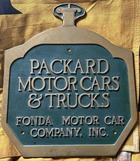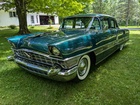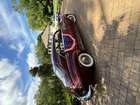|
Re: One Story Assembly Plant What If?
|
||||
|---|---|---|---|---|
|
Home away from home

|
Finally figured it out.
What could Packard have done, that wouldn't cost a lot, like buying Willow Run, but still give some of the advantages of a modern single story plant in terms of material handling, workflow and overhead clearance? Not only was EGB an old style multi-story plant, it was not even rectangular, but followed the even older model of having many narrow wings to maximize the amount of natural light. Those narrow wings provide the opportunity: roof over all the courtyards between the wings of buildings 31-38, at the same level as the roof of the existing wings. Once the roofs are in, knock out the first floor walls of the wings and remove the windows from the 2nd and 3rd floors, turning them into mezzanines. While we're at it, I doubt Packard really needed building 39 as it was built for the Merlin program, so knock it down and rebuild as high bay space. This would only add about net 100,000sqft of workspace for a total of about 370,000sqft on the ground floor, but the name of the game is space free and clear, no pillars, no narrow wings and free movement of workflow and forklifts carrying parts, meanwhile work in the upper floors of 31-38, the subassembly work that was done there before the remod, continues undisturbed. The new high bay areas would have plenty of height. If Packard wanted to put in paint booths and ovens, so they would only have to sub out stamping, they could. If they wanted to bring stamping in house, they would have room for the largest presses they could need. Speaking of presses, I think I figured out why Packard outsourced all the bodybuilding to Briggs when they did. Packard's 1944 annual report has diagrams showing how the wartime work was distributed around the plant, and how work was distributed pre-war. The pre-war diagram shows the "stamping division" in buildings 41-50, with steel storage in 90, which was between the railroad tracks and the 41-50 complex. 41-50 are only one story tall. When GM came out with it's one piece "turret top" roof stampings in 35, the move to larger stampings, and the larger presses needed to make them was on. Even if Packard had wanted to invest in new, larger, presses, the new presses would not have fit in the buildings they had. Confronted with the need to: buy new presses, build new buildings to hold the presses, buy land somewhere on which to build the new buildings (couldn't build where the old stamping division was because that would stop production for a year) Packard did it's usual thing and punted. I have heard two things about the Packard/Briggs deal -Packard didn't keep records of what equipment it moved to Briggs -the price Briggs charged the first couple years was very attractive, but then the price soared. My hunch is Packard bartered the equipment for a discount on the bodies. After the first couple years, the barter agreement ran out and Briggs started charging full price. And to think I was right over in Dearborn, starting in September of 53. Nance could have driven over and asked me what to do....but my language skills were not well developed at that time, so he might not have understood what I was driving at.
Posted on: 2014/6/23 18:15
|
|||
|
||||
|
Re: One Story Assembly Plant What If?
|
||||
|---|---|---|---|---|
|
Home away from home

|
My wife's Aunt Rita moved to Detroit with her husband to seek work in the early years of the Depression. They had left family in Pennsylvania because the mining jobs had dried up, and their Russian-speaking relatives in the Motor City assured them that car plant jobs still existed. Her husband ended working somewhere else, but Rita landed her first and only job at what she still called "the Packards." She worked with other women in the upholstery section where she either put springs or padding into seats. When her husband got re-employed back in PA, she reluctantly quit "the Packards" and moved back and started having babies while he built General Electric locomotives in Erie.
Only recently, did I put the old stories Rita would tell about her days at "the Packards" with what must have been going on all over the EGB plant. From what I've been told, the plant was populated with workers of every description, but many were from Eastern Europe and our southern states. All probably knew that others wanted their scarce jobs and they'd better be good at it or else. I don't know what years Rita worked at Packard, but some of the friendships she made there lasted for 30-40 years. I once tried to pin her down as to the years, but she only told me that she felt lucky to have the job making seats for cars they could never hope to afford. That kind of spirit made them successful later on. Both their kids graduated from good colleges and became leaders in their communities. With that success, the mother who had her one job at "the Packards", was finally able to buy their first new car in the early Fifties. Not a Packard but a new Olds 98. Some stories don't end the way you want them to.
Posted on: 2014/6/23 19:15
|
|||
|
||||
|
Re: One Story Assembly Plant What If?
|
||||
|---|---|---|---|---|
|
Home away from home

|
but Rita landed her first and only job at what she still called "the Packards."
That's something I have noticed about some old autoworkers. In a documentary about Studebaker done by the South Bend PBS station in 83, in observance of the 20th anniversary of Studie's shut down in South Bend, former employees talked about working at "Studebaker's". When my parents first moved to Dearborn in 48, mom worked at the Rouge, and referred to it as "Ford's" Although Ford Motor was the only one of the three that was privately owned, by members of the Ford family, (Ford went public on Jan 17 of 56) it's interesting that employees of all three thought of the company as if it was owned by the person whose name was on the building.
Posted on: 2014/6/24 0:24
|
|||
|
||||








